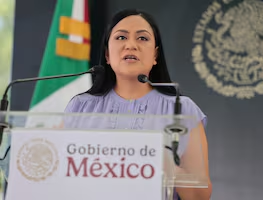Más Información

INE aprueba ampliación presupuestal de 9.2 mdp; se destinará para comprar chalecos en elecciones del Poder Judicial

Sheinbaum anuncia obras de infraestructura en Nayarit; destaca puente que irá de Bahía de Banderas a Puerto Vallarta y un acueducto

Detienen a presunto jefe de célula delictiva allegada a Los Chapitos; se encargaba de narcomenudeo y compra-venta de armamento

“¡Arráncate, Coalcomán!”; así fue la campaña de Anavel Ávila, presuntamente ligada al “Mencho”, para Movimiento Ciudadano

Presupuesto para programas sociales está asegurado en la Constitución: Ariadna Montiel; destaca que se benefician a 320 mil nayaritas

Sheinbaum anuncia construcción de Farmacias del Bienestar en 2025; asegura habrá medicamentos gratuitos para personas vulnerables
Read in Spanish
Hubert James Marcel Taffin de Givenchy
, who went by the name of Hubert de Givenchy, “the last of the aristocratic designers" in the Haute Couture industry- he inherited the title of Marquis of Givenchy from his father- became one of the most iconic fashion designers worldwide, given his outstanding handling of clothing and his major capacity to instil elegance in each of the items he tailored.
Sadly, the fashion house founded and named after him announced of his passing at age 91:
In view of this event, we've collected Givenchy's five key moments that established a before and after in the history of world fashion: his legacy .
1. Structure is everything
Hubert de Givenchy was a pupil of Spanish Haute-Couture designer Cristóbal Balenciaga . The way architecture is implemented in fashion designs to adhere to what would be known by the late 40s as the structured style is one of the lessons Givenchy pursued in the future. Beginning his career in 1945, Givenchy worked with Parisian local fashion designers, tried Law School and finally entered the École Nationale Supérieure des Beaux-Arts . It wasn't until he worked for Italian-born leading Parisian fashion designer Elsa Schiaparelli that his career would take a definite turn.

2. Father to the Prêt-à-porter
Little after the passing of post-war Haute Couture designer Jacques Fath , Hubert de Givenchy presented a ready-to-wear, high-end collection fit for everyday people. Though the trend was conceived as early as the Industrial Revolution in an effort to have products marketed to "ease" daily life, Givenchy is considered one of the Ready to Wear pioneers, with the launch of his Givenchy Université Collection in 1954 which is believed to have been tailored using industrial sewing machines.

3. Films, a second home
It is said that Givenchy entered the film industry thanks to her friend and muse Audrey Hepburn. Still, Givenchy's love for fashion, as well as his close friendship with Hepburn were just a part of the driving force engaging him in film fashion design. At the time, it was quite common that great industry names of the likes of Gabrielle Coco Chanel, Elsa Schiaparelli or Yves Saint Laurent dressed film stars. Saint Laurent would dress Catherine Deneuve in Belle de Jour as Audrey Hepburn in Breakfast at Tiffany's would wear her iconic little black dress by Givenchy to name a few examples.

4. Foray into the beauty industry
During the late 50s and early 60s, the beauty and cosmetic industry appealed both artists and established fashion houses. Givenchy entered the trend with a fashion accessories collection and by launching the famous and iconic perfume, L'Interdit, to be followed by 1959's Vetiver . Today, Givenchy Beauty is a leading cosmetics firm featuring perfumes, make-up and beauty products.

5. Legacy
Givenchy's announced his retirement in 1995, leaving a great Haute Couture empire inherited first from 1995 to 1996 by Hispanic-British designer John Galliano , one of the most controversial and famed fashion designers of the time who redefined the firm aesthetics and introduced clothes separated from the 90s dismal fashion. Galliano was followed by yet another legend in the industry, English fashion designer Alexander McQueen , who bestowed a vibrant and underground audacity to the firm from 1996 to 2000. Welsh fashion designer Julien McDonald brought a more commercial touch to the firm until 2005, when Italian designer Riccardo Tisci became creative director for Givenchy Women's Haute Couture and ready-to-wear lines until 2017. Today English fashion designer Clare Waight Keller serves as Givenchy's first female artistic director . There is no doubt that Givenchy's legacy will uphold for a long time.

bg




